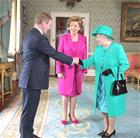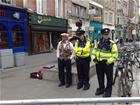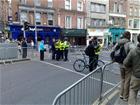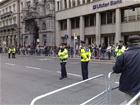To be a proud Irish for a week
Adelina Marini, May 28, 2011
 A thousand kilometers from here (Bulgaria) an event happened that deserves special attention. The British Queen, Elisabeth II, made for the first time an official state visit in the Republic of Ireland, with she which practically opened a new page in the filled with blood and hatred history between the two neighbouring islands. Why does this event deserve special attention? "It is an acknowledgment that while we cannot change the past, we have chosen to change the future". I think that these words of Irish President Mary McAleese explain at best why this event was so important.
A thousand kilometers from here (Bulgaria) an event happened that deserves special attention. The British Queen, Elisabeth II, made for the first time an official state visit in the Republic of Ireland, with she which practically opened a new page in the filled with blood and hatred history between the two neighbouring islands. Why does this event deserve special attention? "It is an acknowledgment that while we cannot change the past, we have chosen to change the future". I think that these words of Irish President Mary McAleese explain at best why this event was so important.
The perfect four days
There was no man in Dublin, whom I spoke to, not to express their admiration with the organisation of the four-day royal visit. Moreover, some even said: "This  week I feel proud to be Irish. Everything was perfect and the police did a great job and did not leave us blocked". The route of the royal person was difficult because she visited several painful for the Irish places. Yet in the very first day of her visit she visited the Garden of Remembrance, where she laid a wreath. This is the memorial of those who died for Irish freedom. Also on Tuesday on May 17, the 27 anniversary of the bombings in Dublin and Monaghan, wreaths were laid at the Talbot Street memorial in remembrance of the 33 people killed in the attacks. Wreaths were laid also at the National War Memorial Gardens in Islandbridge in memory of the nearly 50,000 Irish, who died in the first World War in British uniform. Nowhere in the route Her Majesty spoke, but with her outfit and accessories every time she demonstrated the Irish national symbols.
week I feel proud to be Irish. Everything was perfect and the police did a great job and did not leave us blocked". The route of the royal person was difficult because she visited several painful for the Irish places. Yet in the very first day of her visit she visited the Garden of Remembrance, where she laid a wreath. This is the memorial of those who died for Irish freedom. Also on Tuesday on May 17, the 27 anniversary of the bombings in Dublin and Monaghan, wreaths were laid at the Talbot Street memorial in remembrance of the 33 people killed in the attacks. Wreaths were laid also at the National War Memorial Gardens in Islandbridge in memory of the nearly 50,000 Irish, who died in the first World War in British uniform. Nowhere in the route Her Majesty spoke, but with her outfit and accessories every time she demonstrated the Irish national symbols.
 The culmination of the visit was her speech during the official state dinner in Dublin Castle - the place used by the British monarchy before the independence (1921) for a residence of the viceroy. Elisabeth II appeared in a white satin gown, in the upper part of which were embroidered 2.091 shamrocks - a symbol of Ireland. According to the legend, the shamrock was used by St. Patrick (the man who brought Christianity to Ireland) to illustrate the Trinity. Also a very well planned detail was the decision Her Majesty to wear the tiara, which was a present of the girls of Ireland and Britain for her grand mother - queen Mary in 1893. Elisabeth II received this tiara as a gift for her wedding in 1947.
The culmination of the visit was her speech during the official state dinner in Dublin Castle - the place used by the British monarchy before the independence (1921) for a residence of the viceroy. Elisabeth II appeared in a white satin gown, in the upper part of which were embroidered 2.091 shamrocks - a symbol of Ireland. According to the legend, the shamrock was used by St. Patrick (the man who brought Christianity to Ireland) to illustrate the Trinity. Also a very well planned detail was the decision Her Majesty to wear the tiara, which was a present of the girls of Ireland and Britain for her grand mother - queen Mary in 1893. Elisabeth II received this tiara as a gift for her wedding in 1947.
The biggest opponents to her visit said on its eve that the only thing the queen  could do in order to make them change their mind, was to apologise for the centuries of British occupation. Brian Leeson from the Irish Socialist Workers Party said in an interview with the Sky News that he had three arguments against the visit: Britain is still occupying six Irish counties (in Northern Ireland); Britain is taking part in the occupation of Iraq and Afghanistan; Ireland cannot afford spending 30mn euros for the organisation of the visit. In fact this money were the total amount the country spent for the visits of Her Majesty the Queen and US President Barack Obama.
could do in order to make them change their mind, was to apologise for the centuries of British occupation. Brian Leeson from the Irish Socialist Workers Party said in an interview with the Sky News that he had three arguments against the visit: Britain is still occupying six Irish counties (in Northern Ireland); Britain is taking part in the occupation of Iraq and Afghanistan; Ireland cannot afford spending 30mn euros for the organisation of the visit. In fact this money were the total amount the country spent for the visits of Her Majesty the Queen and US President Barack Obama.
After her delightful speech many commentators noted that it was very close to an apology. "Indeed, so much of this visit reminds of the complexity of our history, its many layers and traditions, but also the importance of forbearance and conciliation. Of being able to bow to the past, but not be bound by it", Her Majesty said. The sentence that is being perceived as closest to an apology is this: "To all those who have suffered as a consequence of our troubled past I extend my sincere thoughts and deep sympathy. With the benefit of historical hindsight we can all see things which we would wish had been done differently or not at all".
 And here is the most important, in my humble opinion, sentence with which Her Majesty reaffirmed what was said up to that moment and opened the new page: "For the world moves on quickly. The challenges of the past have been replaced by new economic challenges which will demand the same imagination and courage. The lessons from the peace process are clear; whatever life throws at us, our individual responses will be all the stronger for working together and sharing the load". Something which Britain proved by helping Ireland in the severe economic situation with a loan.
And here is the most important, in my humble opinion, sentence with which Her Majesty reaffirmed what was said up to that moment and opened the new page: "For the world moves on quickly. The challenges of the past have been replaced by new economic challenges which will demand the same imagination and courage. The lessons from the peace process are clear; whatever life throws at us, our individual responses will be all the stronger for working together and sharing the load". Something which Britain proved by helping Ireland in the severe economic situation with a loan.
The words of the Irish President were extremely wise and unveiled maturity of such a kind that history assesses as a transition to a next stage of evolution: "The harsh facts cannot be altered nor loss nor grief erased but with time and generosity, interpretations and perspectives can soften and open up space for new accommodations".
Those who can forgive will be forgiven
Precisely 90 years ago Ireland received its independence, but the United Kingdom  kept the northern part of the smaller island - Northern Ireland, which is still a reason for bitterness between the two countries. But nonetheless, both countries admit that the Good Friday Agreement of 1998 is a good basis for a further solving of the problem and the final closure of this chapter of the history between the two nations. The four-day visit of Queen Elisabeth II proves the axiom that those who learn from the past build a better future.
kept the northern part of the smaller island - Northern Ireland, which is still a reason for bitterness between the two countries. But nonetheless, both countries admit that the Good Friday Agreement of 1998 is a good basis for a further solving of the problem and the final closure of this chapter of the history between the two nations. The four-day visit of Queen Elisabeth II proves the axiom that those who learn from the past build a better future.
On my leaving Dublin I spoke to the taxi driver that took me to the airport. I asked him too how did he assess the royal visit. He said he was happy, because everything was already in the past. The commercial and economic ties between the two islands are so many that it is not worth being prevented by the past. It is also true, however, that in Ireland there are still groups that will oppose the reconciliation until the 6 counties, still under British control, are not returned to Ireland. They staged several protests during the royal visit but, as all commentators and media explained, they were very poorly organised and small in numbers to be able to cause problems. In the country's parliament, the Dael, there were also objections. During the time for leaders questions an independent MP asked Premier Enda Kenny to hold a debate on the visit.
 The security measures were at the highest level, as threats were not lacking, some of which appeared to be just an attempt to attract attention. The media in the entire political spectrum were unanimous - this visit has brought closer our countries. "Britain has simply made the best gesture of all, a bilateral loan that was pragmatic and effective", Bruce Arnold wrote in The Irish Independent. In an editorial The Irish Times points out that the timing of the visit could not have been better. Not only that she reaffirmed a process that has been going on for a long time, but her visit also helped raise the national self-confidence. The newspaper is also delighted with the perfect organisation of the visit.
The security measures were at the highest level, as threats were not lacking, some of which appeared to be just an attempt to attract attention. The media in the entire political spectrum were unanimous - this visit has brought closer our countries. "Britain has simply made the best gesture of all, a bilateral loan that was pragmatic and effective", Bruce Arnold wrote in The Irish Independent. In an editorial The Irish Times points out that the timing of the visit could not have been better. Not only that she reaffirmed a process that has been going on for a long time, but her visit also helped raise the national self-confidence. The newspaper is also delighted with the perfect organisation of the visit.
"The organisation of the visit was superb. Most of the worldwide media coverage  was, for a change, positive. The banks were, for one week at least, knocked off our front pages. [...] But beyond these temporary fillips, the visit had a deeper impact on Ireland's consciousness in these dark times. The loss of economic sovereignty implicit in the bailout deal has done a great deal of damage to Irish pride in being an independent nation. It meant a lot that the embodiment of the old imperial power behaved with such exquisite courtesy towards the symbols of that independence.The historical ironies in Anglo-Irish relationships have tended to be nasty ones, but here was a pleasant paradox. It took a British queen to remind us that we are still a free, sovereign country, equal to any other. That was, after all the complications of our mutual history, a deeply friendly act".
was, for a change, positive. The banks were, for one week at least, knocked off our front pages. [...] But beyond these temporary fillips, the visit had a deeper impact on Ireland's consciousness in these dark times. The loss of economic sovereignty implicit in the bailout deal has done a great deal of damage to Irish pride in being an independent nation. It meant a lot that the embodiment of the old imperial power behaved with such exquisite courtesy towards the symbols of that independence.The historical ironies in Anglo-Irish relationships have tended to be nasty ones, but here was a pleasant paradox. It took a British queen to remind us that we are still a free, sovereign country, equal to any other. That was, after all the complications of our mutual history, a deeply friendly act".
After everything I saw that last week of my stay in Ireland, which coincided with the Queen's visit, now I clearly see why that interlocutor of mine told me "This week I am proud to be Irish". I envied him, greatly.